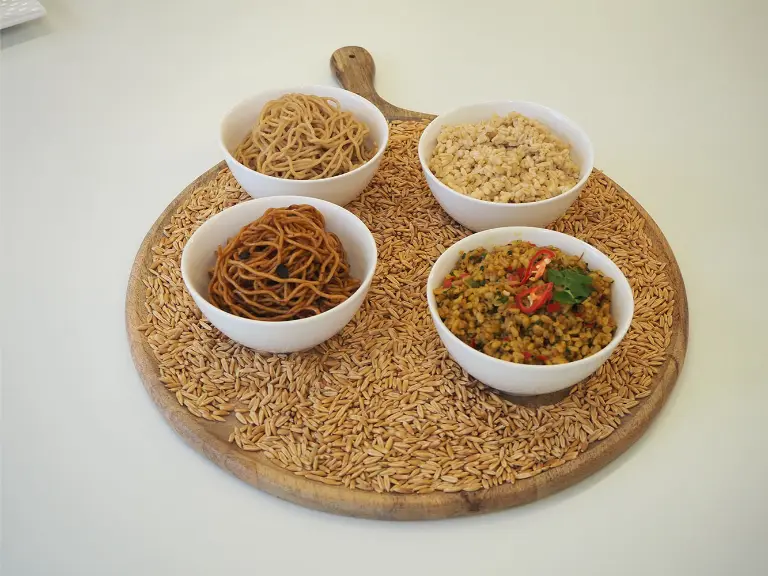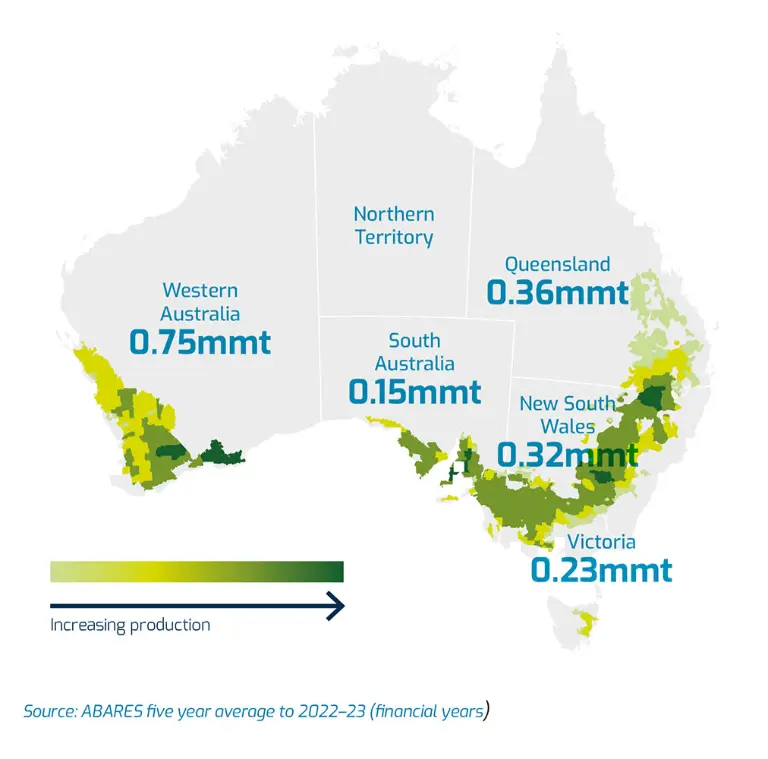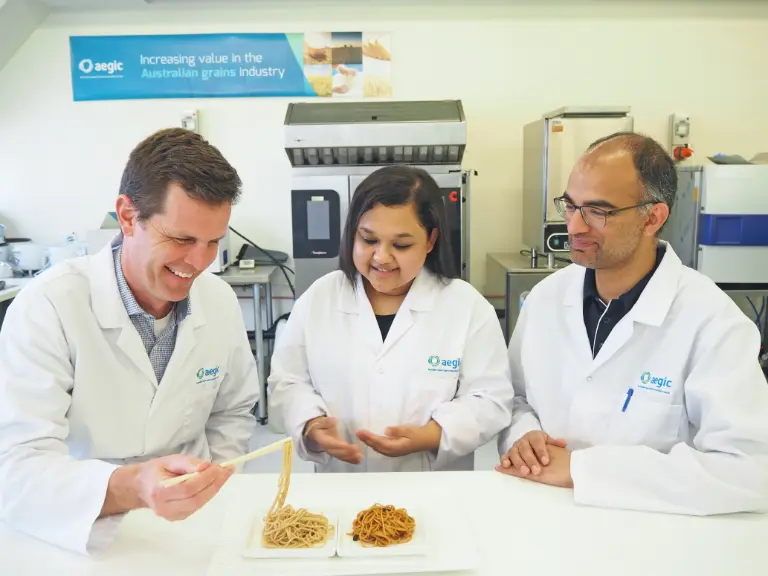Oats
Australian oats are highly sought after for healthy food products, such as oatmeal porridge, snack foods and innovative new products such as noodles and rice.
This website may not work correctly in Internet Explorer. We recommend switching to a more secure modern web browser such as Microsoft Edge which is already installed on your computer.
Widely recognised for their nutritional and health benefits, Australian oats stand out for their high quality, excellent taste, brightness, low moisture content and superior processing characteristics including high milling yield and groat percentage.
The magic of oats is down to the fact that they are high in beta-glucan (also known as β-glucan). Beta-glucan is a soluble dietary fibre that has unique nutritional benefits, including a proven ability to reduce the risk of lifestyle diseases.
Unlike many wheat products, oats usually do not have the bran and germ removed during processing, so most oat foods contain whole grain oats, which are rich in healthy beta-glucan.
Australian oats are sought after for an increasingly wide range of food products, including:

Traditionally, oats have mainly been used for oatmeal porridge, breakfast cereals and snacks.
As awareness of the health benefits of oats grows, there is an increasing appetite to increase the use of oats in a wider range of products, including lunch and dinner-style foods.
The Australian oats industry invests in a range of projects to increase the value of Australian oats for both growers in Australia and customers in international markets.
AEGIC developed innovative processing technology for Asian-style noodles made from 100% whole grain oats, as well as an oat ‘rice’ product that can be cooked and eaten like regular white rice. Australian company My Plantco-Real Oats is now developing products using AEGIC’s technology to bring to consumers.
AEGIC is also investigating a range of other innovative oat products and ingredients, including semolina products such as couscous and halwa, and beta-glucan-rich fractions as healthy thickeners for sauces, dressings, and as a fortifier for Asian-style bread and bubble tea pearls.
These products will make it much easier for consumers to make the switch to healthier whole grain oat options for breakfast, lunch and dinner.
AEGIC’s research has received investment from the Grains Research and Development Corporation, the Western Australian State Government, and the Processed Oats Partnership (POP).

The growing prevalence of lifestyle diseases such as obesity and heart disease is a major cause for concern for governments and health authorities around the world.
Studies have shown that consuming oats can:
Oat consumption has been associated with a reduced risk of cardiovascular disease. Beta-glucan in oats reduces overall cholesterol levels by removing LDL or ‘bad cholesterol’ from our bodies.
Consuming 3 grams of beta-glucans daily, which is roughly 75 grams or two-thirds of a cup of oats, can lower blood and LDL cholesterol levels.
Oats’ high fibre content also helps lower the risk of high blood pressure, reducing the strain on the heart and arteries.
The Australian oat industry is committed to increasing the awareness of the health benefits of Australian oats in Asian markets. AEGIC regularly engages with customers in key markets to communicate the benefits of Australian whole grains, including oats. Consuming Australian oats is an excellent way to improve health outcomes in Asian markets and around the world. Supplementing traditional foods like wheat noodles and white rice with whole grain oat products makes this an easy and attractive option for consumers.

Consuming Australian oats is an excellent way to improve health outcomes in Asian markets and around the world. Supplementing traditional foods like wheat noodles and white rice with whole grain oat products makes this an easy and attractive option for consumers.

Australian oats are grown in southwest Western Australia, the Eyre and Yorke Peninsulas of South Australia, western and north-eastern Victoria, and the Riverina and central New South Wales. On average, Australia produces about 1.5mmt of oats across 890,000 hectares. On average, 5-10% of the world’s oat supply is produced by Australia. *
Australian oat growers operate in one of the cleanest environments in the world, using state of the art farming techniques to produce clean, dry, food-safe oats that meet customer requirements.
Western Australia is by far the largest oat producing state, followed by New South Wales and Victoria.

Australian oats have an excellent reputation in Asian markets and around the world. China is Australia’s largest market for oats, with other markets including Mexico, Japan and India.
On average, Australia exports around 400,000 tonnes * of oats (processed and raw) worth over $200 million. *
* Data is obtained from multiple third party sources. Due care is taken to verify the information, however it is acknowledged that some data may be incomplete due to commercial confidentiality relating to grain trading, or other restrictions.

The Australian oats industry is dedicated to assuring the highest level of quality for customers of Australian oats.
The National Oat Breeding Program conducts the breeding and development of new oat varieties with superior quality in Australia. This program is delivered by InterGrain, with co-investment from the Grains Research and Development Corporation (GRDC) and the Western Australian State Government.
Oat varieties are developed to meet the requirements of international consumers. Varieties released with a milling classification must have a high hectolitre weight with low screenings, high groat percentage and milling yield, a good level of beta-glucan, and superior taste and aroma.
Grain Trade Australia and the Grain Industry Association of Western Australia define standards for the segregation of oats grown by farmers based on their quality.
Grains Australia manages classification, market access, market insights and market education on behalf of the Australian oats industry.

The Australian oats industry is committed to growing the value of Australian oats for both Australian growers and international consumers.
The Processed Oat Partnership (POP) is an industry-led program, supported by the Western Australian State Government and led by the Grain Industry Association of WA (GIWA), which will provide a foundation for growth in the oat industry over the next 20 years through research, market insights, and innovation in oat breeding and product development.
The Oat Grain Quality Consortium (OGQC) is a collaborative Grains Research and Development Corporation (GRDC) investment aimed at addressing the crucial need for innovation in oat quality research, informing oat quality classification and market positioning.
These programs complement each other to support the development of the Australian oat industry. AEGIC is a key collaborator across each of the programs, providing market insights and innovation expertise.
AEGIC is delivering three projects with investment from the Processed Oats Partnership:

These programs complement each other to support the development of the Australian oat industry. AEGIC is a key collaborator across each of the programs, providing market insights and innovation expertise.
 Read more
Read more Read more
Read more Read more
Read more Read more
Read more Read more
Read more